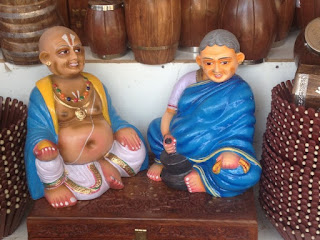Integrating art with festive traditions creates innovative and unique narratives, which also add a contemporary touch to traditional tableau, writes art consultant Nalini S Malaviya
Traditional rituals offer a great opportunity to reiterate customs and traditions, and help in bringing alive oral histories for the younger generation. The doll festival, Gombe Habba, which is held during Dussehra in Southern parts of India, involves displaying traditional and rare dolls, figurines, heirlooms, artefacts and toys on a tiered platform. The various arrangements in which the dolls are exhibited are unique to family customs but adopt creative modes of storytelling, while focusing on the décor as well. Traditional themes and mythological tales are popular motifs in building the tableau, but contemporary issues are also now becoming part of exhibits.
The doll festival with its rich plurality of artefacts is a wonderful example of the fine craft traditions in India, and many times involves sourcing dolls from across the length and breadth of the country – a practice which is valuable in giving a boost to indigenous crafts. The Gombe is a great way to build narratives around folk traditions and mythological characters and to revive traditional rituals and renew interest in age old crafts. Antique dolls, such as those that have been in families for generations add historicity and interest to the decorations. Therefore the Gombe can be an effective combination of art and craft, tradition and décor.
Some of the key elements involved in creating an outstanding display are creativity, the material such as dolls and toys in this case and the format of the exhibit. To form unusual and enchanting narratives and décor, art can be used to enhance the display and to add interest. For instance, contemporary art which is based on reinterpretation of Indian mythology and borrows from traditional motifs, or art which is adapted from folk and tribal arts can be used very effectively along with traditional dolls in the Gombe to create new and unusual vocabularies.
Similarly, contemporary statues and figurines that are based on traditional forms and motifs can be a great addition to the main exhibit. Two dimensional artwork in the form of canvas and silk paintings and tapestries can form the perfect backdrop to the exhibit and also be an integral element in the storytelling. Contemporary art which is based on religious iconography is also a value addition from a décor perspective and in creating inventive exhibits.

The storytelling in the tableaus narrate vignettes from the epics, Ramayana and Mahabharata, however, modern themes around urban issues pertaining to gender, environment, and water and natural resources are also being depicted these days. In portraying modern ills and concerns, contemporary art can augment and emphasize the theme and convey the message effectively, while covering large expanses with artwork.
It is important to rekindle awareness about traditional rituals and by adopting innovative measures one can renew interest in their significance, create innovative décor trends and encourage a celebratory atmosphere.
Published in Times Property, Bangalore
If you enjoyed reading this article, do share it using the social media widgets at the top and subscribe to receive regular updates from Art Scene India
Related Posts,
- Abstract Art for Interiors
- Art on Rugs and Tapestries
- Artistic Expressions with Glass
- Miniature Paintings in Home Décor
- Painting a Wall
- Art for Festive Occasions
- Art in Interiors: Art With Paper
- Displaying Art in Home Interiors
- Hyperreal Art Makes An Impact
- Art in Interiors: Murals Bring Art to Interiors
- Chromatic Frames to Display Art
- A Tradition of Textile Art
- Art Installations to Complement Home Decor
- Festive Home Decor : A tradition of lighting the lamp
- Art In Home Decor
- Integrate Art With Architecture
- Style Statement With Art
- Antiques in Home Decor










